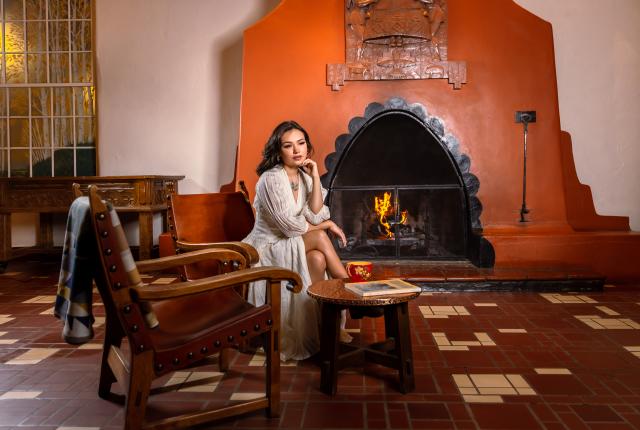TRAVEL ANY DISTANCE IN NEW MEXICO between sunrise and sunset and eventually you’ll start to envision a soft place to rest your head. Spanish colonists caravanning north along the Camino Real called such a stop a paraje: a small oasis or settlement where travelers could camp for the night, dine, water their horses and themselves, and maybe have a dream or two.
After a long day’s journey, you might be lucky enough to walk into a place like the lobby at Santa Fe’s La Fonda on the Plaza, which turns 100 years old this year.
“This was a hotel,” mystery writer Dorothy B. Hughes wrote of the “Inn at the End of the Trail” in her 1946 novel Ride the Pink Horse. “It didn’t look like a hotel; it was more like a Spanish hacienda. … Cool, dark and rich, a high, timbered ceiling, soft leather couches and chairs. There were oil paintings on the walls.”
New Mexico’s grand old hotels—spun from adobe, brick, tin, tile, and proximity to trails, rails, and eventually highways—represent the culmination of the paraje. Some of them bear the hallmarks of luminaries in American hospitality like Fred Harvey and Conrad Hilton, a San Antonio, New Mexico, native who grew up to lead a hotel empire (but married Zsa Zsa Gabor at La Fonda). They represent not simply a place to sleep, but to dream extravagantly—a perch from which to grasp the past while making the most of the elegant present.
Maybe you’ve scanned the bar’s ceiling at the St. James Hotel in Cimarrón, counting bullet holes from Wild West shootouts, or gazed over Albuquerque from an upper-level room at Hotel Andaluz, mapping out the city from what was once its tallest building. Perhaps you’ve read Diné poet Jake Skeets’s haunting ode “A List of Celebrities Who’ve Stayed at the El Rancho Hotel” in Gallup, or recognized the Plaza Hotel in Las Vegas (New Mexico, that is) from a harrowing scene in the film No Country for Old Men. Or, like me, you’ve smirked with your boyfriend at the naughty D.H. Lawrence paintings tucked away at Hotel La Fonda de Taos. Maybe you’ve simply gone for the food: locally raised lamb birria from Campo at Los Poblanos Historic Inn, or duck-fat-fried oysters with green chile and chorizo at the Andaluz’s Más Tapas y Vino.
In these grande dames, you become part of a living legacy. Each one has seen seasons of glory and years of neglect, been reincarnated by renovations, and stood sentry through eras of both progress and decline. They’re the most interactive, romantic, and relaxing museums New Mexico has to offer.
It’s often the road less traveled that leads to these hotels. Their storied rooms offer a reward for ignoring the chain motels just off the highway. In them, you can embody the Spanish settler, the Indigenous artist, the American outlaw, or the turn-of-the-century train traveler—or simply appreciate fine art and craftsmanship, the efforts of preservationists, and a cocktail made with local spirits sipped beside a vintage fireplace.
It requires more than a savvy hotelier to keep these gems polished and profitable. It also takes a community that recognizes their value.
“People go to these classic structures because they’re meaningful,” says Allan Affeldt, who revitalized Las Vegas’s crown jewels, the 1882 Plaza Hotel and 1898 Castañeda Hotel. “They were the center of the town. It’s where everything happened: weddings, funerals, business meetings.”
The Fred Harvey Company is central to the story of New Mexico’s most enduring hotels. The Castañeda was the first trackside hotel in the Southwest operated by the hospitality company, which contracted with the Atchison, Topeka & Santa Fe Railway to bring good food and classy digs to rail riders between 1876 and 1968. New Mexico’s railroad hotel legacy extends, Affeldt explains, “from the Harvey hotels that are gone, like the Alvarado in Albuquerque, to the ones that are endangered, like the Gran Quivira in Clovis, to the ones that have been restored, like the Castañeda, to the ones that have always been there, like La Fonda. It’s unique in the country.”
Just as the Harvey company curated travelers’ experiences of New Mexico—dictating everything from menus to the embroidered Mexican blouses worn by Harvey Girl waitresses at La Fonda—so do today’s hotel stewards. Jenny Kimball, chair of La Fonda’s board, is hyper-conscious of the hotel’s tradition of featuring local and Indian Market artists. “The art and the history is what people respond to,” she says. In La Fonda’s newer rooms, headboards are upholstered with repurposed Navajo blankets and contemporary artworks line the walls, while the hotel’s oldest suites still boast original floors, fireplaces, and works from the famed Studio School at the Santa Fe Indian School. “They’re historic,” she says of her beloved rooms, “but you don’t feel like you’re in your grandmother’s house.”
The fine balance between a mysterious past and an awe-inspiring present keeps us coming back to hotels like La Fonda. It’s the kind of magical place that spurred painter Jerry West’s uncle to ride a horse into the cantina during a long-ago and raucous Santa Fe Fiesta celebration and, decades later, motivated Stevie Wonder to use suite 500 as a home base to record songs for his compilation double album Original Musiquarium I. These stately structures stake a special claim to history—and our hearts. “Every one of these buildings,” says Affeldt, “is a voyage of discovery.”
Learning La Fonda
French writer Simone de Beauvoir called it “the most beautiful hotel in America, perhaps the most beautiful I’ve ever seen.” Lift a glass to La Fonda’s 100 years of hospitality at its March 26 Centennial Gala, and soak up its history with the Centennial Speaker Series, held throughout 2022. On March 25, join Jenny Kimball, chair of the hotel’s board, architect Barbara Felix, and director and producer Katrina Parks (The Harvey Girls: Opportunity Bound) for a panel discussion, “Celebrating the Women of La Fonda.” 100 E. San Francisco St., Santa Fe; 505-982-5511.



